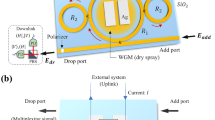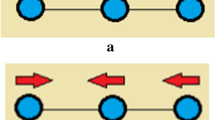Abstract
We propose the use of the specific form of the integrated device known as the boxcar filters for big data transmission, where the advantage of such device is the number of roll-off (bandwidth) can be increased to meet the large demand of the future bandwidth requirements. A boxcar filter system is formed by the serial Panda-ring resonators, where the initial and end rings are used to form the whispering gallery mode beams for the light fidelity (LiFi) up-down-link conversion. There are 5 boxcar circuits within the system. Each of boxcar devices has the electro-optic connection that can be used to perform the external signal processing applications, where all electronic signals are changed to be the light signals and connected to the network via the free-space up-down link nodes. In a simulation, the selected light source is fed into the boxcar filters via the input port, in which the single roll-off bandwidth of 300 THz is obtained. The frequency guard band is given by each boxcar separation. In applications, the electromagnetic immunity interference (EMI) signals can be obtained by the electro-optic conversion circuit, which is the medical instrument specification requirement. The low EMI signals can be connected to the network and transmission using the LiFi network to the remote area. In addition, the medical information to home using the big data via the ad hoc LiFi network and the internet of thing platform arrangements are also proposed.






Similar content being viewed by others
References
Fusco, G., Bracci, A., Caligiuri, T., Colombaroni, C., & Isaenko, N. (2018). Experimental analyses and clustering of travel choice behaviours by floating car big data in a large urban area. IET Intelligent Transport Systems,12, 270–278.
Zhuang, Z., Ramachandra, H., & Xiong, C. (2015). Taming replication latency of big data events with capacity planning. Computer,48, 36–41.
Mao, M., Yue, Y., & Chang, L. (2016). Multi-time scale forecast for schedulable capacity of Electric Vehicle fleets using big data analysis. In 2016 IEEE 7th international symposium on power electronics for distributed generation systems (PEDG) (pp. 1–7).
Mao, M., Wang, Y., Yue, Y., & Chang, L. (2017). Multi-time scale forecast for schedulable capacity of EVs based on big data and machine learning. In 2017 IEEE, Energy conversion congress and exposition (ECCE) (pp. 1425–1431).
Atabaki, A. H., Moazenni, S., Pavanello, F., et al. (2018). Integrating photonics with silicon nanoelectronics for next generation of system on a chip. Nature,556, 349–354.
Bahadoran, M., & Yupapin, P. (2018). All-optical notch filters for ultra-wideband chaotic communications. European Journal of Physics Plus, 133, 487.
Wang, H., Chen, Z., Zhao, J., Di, X., & Liu, D. (2018). A vulnerability assessment method in industrial internet of things based on attack graph and maximum flow. IEEE ACCESS,6, 8599–8609.
Liu, Z., Choo, K.-K. R., & Grossschadl, J. (2018). Securing edge devices in the post-quantum internet of things using lattice-based cryptography. IEEE Communications Magazine,56, 158–162.
Zhao, L., & Dong, X. (2018). An industrial internet of things feature selection method based on potential entropy evaluation criteria. IEEE Access,6, 4608–4617.
Mumtaz, S., Bo, A., Al-Dulaimi, A., & Tsang, K.-F. (2018). 5G and beyond mobile technologies and applications for industrial IoT (IIoT). IEEE Transactions on Industrial Informatics,14(6), 2588–2591.
Cai, Y., Chen, X., Yu, J., & Zhou, J. (2018). Numerical study on the evolution of mesoscopic properties and permeability in sandstone under hydromechanical coupling conditions involving industrial internet of things. IEEE Access,6, 11804–11815.
AlKalaa, M. O., Balid, W., Refai, H. H., LaSorte, N. J., Seidman, S. J., Bassen, H. I., et al. (2017). Characterizing the 2.4 GHz spectrum in a hospital environment: Modeling and applicability to coexistence testing of medical devices. IEEE Transactions on Electromagnetic Compatibility,59, 58–66.
Tang, C.-K., Chan, K.-H., Fung, L.-C., & Leung, S.-W. (2009). Electromagnetic interference immunity testing of medical equipment to second-and third-generation mobile phones. IEEE Transactions on Electromagnetic Compatibility,51, 659–664.
Wan, F., Duval, F., Savatier, X., Louis, A., & Mazari, B. (2012). Electromagnetic interference detection method to increase the immunity of a microcontroller-based system in a complex electromagnetic environment. IET Science, Measurement and Technology,6, 254–260.
Li, H. G., Bai, H. X., Xie, S. G., & Su, D. L. (2015). Bulk-driven CMOS amplifier with high EMI immunity. IEEE Transactions on Electromagnetic Compatibility,57, 1425–1434.
Richelli, A., Colalongo, L., Quarantelli, M., & Kovács-Vajna, Z. M. (2004). Robust design of low EMI susceptibility CMOS OpAmp. IEEE Transactions on Electromagnetic Compatibility,46, 291–298.
Redouté, J.-M., & Baghini, M. S. (2018). A generic EMI-immune technique for differential amplifiers with single-ended output. IEEE Transactions on Electromagnetic Compatibility,60, 958–964.
Soysouvanh, S., Jalil, M., Amiri, I., Ali, J., Singh, G., Mitatha, S., et al. (2018). Ultra-fast electro-optic switching control using a soliton pulse within a modified add-drop multiplexer. Microsystem Technologies,24(9), 3777–3782.
Haas, H., Yin, L., Wang, Y., & Chen, C. (2016). What is lifi? Journal of Lightwave Technology,34, 1533–1544.
Sarkar, A., Agarwal, S., & Nath, A. (2015). Li–Fi technology: Data transmission through visible light. International Journal of Advance Research in Computer Science and Management Studies, 3(6), 1–10.
Yadav, M. S., Mishra, M. P., Velapure, M. M., & Togrikar, P. (2016). LI–FI technology for data transmission through LED. Imperial Journal ofInterdisciplinary Research, 2(6), 21–24.
Sharma, S., & Bansal, N. (2016). Li-Fi (Light fidelity)-the future technology in wireless communication. International Journal of Advanced Research in Computer Science, 7(6), 258–262.
Chaiwong, K., Bahadoran, M., Amiri, I. S., Youplao, P., Pornsuwancharoen, N., & Yupapin, P. (2018). Electro-optic conversion circuit incorporating a fiber optic loop. Microwave and Optical Technology Letters. https://doi.org/10.1002/mop.31575.
Punthawanunt, S., Aziz, M. S., Phatharacorn, P., Chiangga, S., Ali, J., & Yupapin, P. (2018). LiFi cross-connection node model using whispering gallery mode of light in a microring Resonator. Microsystem Technologies,24(12), 4833–4838.
Sarapat, N., Pornsuwancharoen, N., Youplao, P., Amiri, I. S., Jalil, M. A., Ali, J., et al. (2018). LiFi up-downlink conversion node model generated by inline successive optical pumping. Microsystem Technologies,5, 945–950.
Smektala, F., Quemard, C., Leneindre, L., Lucas, J., Barthélémy, A., & De Angelis, C. (1998). Chalcogenide glasses with large non-linear refractive indices. Journal of Non-Crystalline Solids,239, 139–142.
Zakery, A., & Elliott, S. R. (2007). Optical nonlinearities in chalcogenide glasses and their applications (Vol. 135). Berlin: Springer.
Pornsuwancharoen, N., Youplao, P., Amiri, I., Ali, J., & Yupapin, P. (2017). Electron driven mobility model by light on the stacked metal–dielectric interfaces. Microwave and Optical Technology Letters,59, 1704–1709.
Pornsuwancharoen, N., Amiri, I. S., Suhailin, F., Aziz, M., Ali, J., Singh, G., et al. (2017). Micro-current source generated by a WGM of light within a stacked silicon–graphene–Au waveguide. IEEE Photonics Technology Letters,29, 1768–1771.
Mitkova, M., & Boncheva-Mladenova, Z. (1987). Selective solubility of some silver-chalcogenide glasses. Journal of Non-Crystalline Solids,90, 589–592.
Roscoe, A. J. & Blair, S. M. (2016). Choice and properties of adaptive and tunable digital boxcar (moving average) filters for power systems and other signal processing applications. In 2016 IEEE international workshop on, applied measurements for power systems (AMPS) (pp. 1–6).
Gall, D. (2016). Electron mean free path in elemental metals. Journal of Applied Physics,119, 085101.
Baccarani, G., & Ostoja, P. (1975). Electron mobility empirically related to the phosphorus concentration in silicon. Solid-State Electronics,18, 579–580.
Chaiwong, K., Tamee, K., Punthawanunt, S., Suhailin, F., Aziz, M., Ali, J., et al. (2018). Naked-eye 3D imaging model using the embedded micro-conjugate mirrors within the medical micro-needle device. Microsystem Technologies,24(6), 2695–2699.
Bahadoran, M., Ali, J., & Yupapin, P. P. (2013). Ultrafast all-optical switching using signal flow graph for PANDA resonator. Applied Optics,52, 2866–2873.
Karim, M., Rahman, B., & Agrawal, G. P. (2015). Mid-infrared supercontinuum generation using dispersion-engineered Ge 11.5 As 24 Se 64.5 chalcogenide channel waveguide. Optics Express,23, 6903–6914.
Asobe, M., Suzuki, K. I., Kanamori, T., & Kubodera, K. I. (1992). Nonlinear refractive index measurement in chalcogenide-glass fibers by self-phase modulation. Applied Physics Letters,60, 1153–1154.
Sud, S., Want, R., Pering, T., Rosario, B., & Lyons, K. (2008). Enabling rapid wireless system composition through layer-2 discovery. IEEE Network,22(4), 14–20.
Chen, H.-C. (2017). TCABRP: A trust-based cooperation authentication bit-map routing protocol against insider security threats in wireless ad hoc networks. IEEE Systems Journal,11, 449–459.
Chaiyasoonthorn, S., Limpaibool, P., Mitatha, S., & Yupapin, P. P. (2010). High capacity mobile ad hoc network using THz frequency enhancement. International Journal of Communications, Network and System Sciences,3, 954.
Derkachova, A., & Kolwas, K. (2007). Size dependence of multipolar plasmon resonance frequencies and damping rates in simple metal spherical nanoparticles. The European Physical Journal Special Topics,144, 93–99.
Tunsiri, S., et al. (2019). Microring switching control using plasmonic ring resonator circuits for super-channel use. Plasmonics,14, 1669–1677.
Ali, J., Youplao, P., Pornsuwancharoen, N., Jalil, M. A., Aziz, M. S., Amiri, I. S., et al. (2018). On-chip electro-optic multiplexing circuit using serial microring boxcar filters. Results in Physics,10, 18–21.
Acknowledgements
The authors would like to acknowledge the research facilities from Rajamangala University of Technology Phra Nakhon, Bangkok, Thailand and Ton Duc Thang University, Vietnam.
Author information
Authors and Affiliations
Corresponding author
Additional information
Publisher's Note
Springer Nature remains neutral with regard to jurisdictional claims in published maps and institutional affiliations.
Rights and permissions
About this article
Cite this article
Bunruangses, M., Chaiwong, K., Amiri, I.S. et al. High-Density Wavelength Multiplexing Model for THz-EMI Transmission. Wireless Pers Commun 113, 1225–1239 (2020). https://doi.org/10.1007/s11277-020-07276-4
Published:
Issue Date:
DOI: https://doi.org/10.1007/s11277-020-07276-4




